Yes, it was sore...
So what happened next was that after much (OK, 10 minutes) deliberation, the wisest course of action (considering the track record of Bolivian transportation) was to head straight back to La Paz so that we didn't miss our excursion on "The World's Most Dangerous Road"...
As I mentioned in the previous entry, I didn't get to see much of La Paz last time I was there (accursed trout!), turns out that was no great loss. I know this is a personal preference issue, and that one man’s vibrant exciting cosmopolitan street life is another man’s stinking, crowded, charmless cess pit, but you’ve gotta have an opinion in this life! Guess which side I came down on…
On the positive side, there was something I really liked about La Paz: its wonderful sense of order when it came to the organization of streets by items you could buy there. For example, the was a whole street devoted to Hats, Lightbulb Lane (all apparently wired to one streetlamp),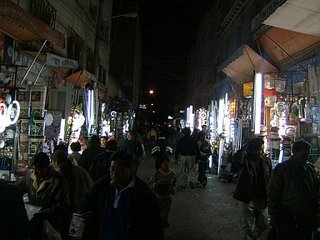 Wedding Cake Boulevard, Plastic Tubing Avenue, Petticoat Lane (knowing reference for the London dwellers out there…) Dog Accessory Alley, and Moldy Banana Drive to name but a few.
Wedding Cake Boulevard, Plastic Tubing Avenue, Petticoat Lane (knowing reference for the London dwellers out there…) Dog Accessory Alley, and Moldy Banana Drive to name but a few.
Took another tumbled on the crumpled concrete streets, even BEFORE I’d got to the pub, and did my ankle in again. Poor me, please be generous with your sympathy. That night a Manchester Barman, of the totally mad, wired and in your face variety, was very nice to me and gave me a copy of the most wonderful book: “Kiss My Tiara” by Susan Jane Gilman. I can wholeheartedly recommend that everyone, both male and female, read this book. It’s very funny, insightful, and gives a painfully truthful A to Z of why women have sex. Just call me Oprah!
Went to an incredibly interesting little museum in La Paz: the Coca Museum. Now I only have half remembered facts here, so please do some of your own research about how soundly dicked the people of Bolivia have been over the little coca leaf, first by the Spanish and then, of course, by the USA! The Coca leaf was revered by the Andean people, with religious significance to Pachamama (Mother Earth), as a stimulant to help them work harder and ignore their hunger pangs, and also as a breathing aid in the high altitudes. The Spanish Inquisition decided the chewing of coca leaves was a mortal sin (unless it was used by the miners, who provided Spain with so much of their wealth), and then in the 1950s declared as a source of evil by Uncle Sam, who despite having only 5% of the world’s population consumes 50% of the world’s cocaine. Anyway, enough of my 6th Form Common Room rant and back to the blogging, right kids!
An early start on the morning of the 12th for our bike ride on ‘The World’s Most Dangerous Road’ from La Paz to Coroico in the Yunga region of Bolivia. What the hell was I thinking? The starting point was at a pleasant oxygen depleted altitude of 4760 meters, (15.616,80 feet). A bit hard to catch you’re breath when you’re nervous, excited and trying to get used to being on a $2500 full suspension bike. Which is the right break to use? How do I change gears?? What’s the point of changing gears??? Help, I’m, flap-lining!!!!
The starting point was at a pleasant oxygen depleted altitude of 4760 meters, (15.616,80 feet). A bit hard to catch you’re breath when you’re nervous, excited and trying to get used to being on a $2500 full suspension bike. Which is the right break to use? How do I change gears?? What’s the point of changing gears??? Help, I’m, flap-lining!!!!
Anne, our intimidatingly muscled guide, gave us a suitably terrifying safety talk (“prick about or look at the scenery and you will die, quickly if you’re lucky”), then told us she wanted our group to be first at the finishing point hotel so she could get a hot shower. No pressure then…
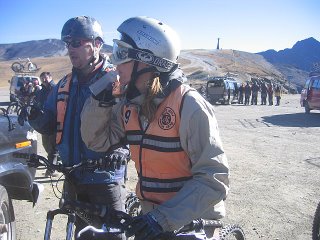 After a quick offering to Pachamama of each of us taking a swig of 97% proof alcohol then dribbling some into the ground for Her, we were off. Some at a slower pace than others… There were some killer uphill sections on the normal paved road, then it was onto the real bad-boy stuff.
After a quick offering to Pachamama of each of us taking a swig of 97% proof alcohol then dribbling some into the ground for Her, we were off. Some at a slower pace than others… There were some killer uphill sections on the normal paved road, then it was onto the real bad-boy stuff. 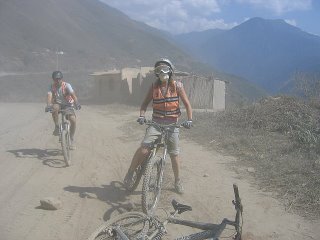 A rough gravel track, 3.2 m (10.5 ft) wide in places with 1000m (3280 ft) drops. Plus the fact you’re sharing the road with minibuses, full size buses, trucks and even petrol tankers in both directions.
A rough gravel track, 3.2 m (10.5 ft) wide in places with 1000m (3280 ft) drops. Plus the fact you’re sharing the road with minibuses, full size buses, trucks and even petrol tankers in both directions.
 There are people employed to stand at particularly perilous sections of the road to alert cyclists if it is safe to carry on. I was so accustomed to their signs being green that I didn’t register when one chap was excitedly waving a big red one at me, so I just sailed past, trilling a merry “Hola!” at him as I went. Luckily I heard Paul screaming at me just before I had a head to head to a sizable truck. I paid lots more attention to the roadside saviours after that…
There are people employed to stand at particularly perilous sections of the road to alert cyclists if it is safe to carry on. I was so accustomed to their signs being green that I didn’t register when one chap was excitedly waving a big red one at me, so I just sailed past, trilling a merry “Hola!” at him as I went. Luckily I heard Paul screaming at me just before I had a head to head to a sizable truck. I paid lots more attention to the roadside saviours after that…
An average of 29 vehicles and 4 cyclists go over the edge every year. As you can imagine, the survival rate ain’t exactly high…
After 64 KM (40 miles) we reached our destination, Yolosa, dirty, sweaty, tired but happy.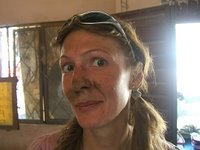
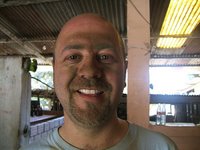 We took a bus to Coroico for a shower and a relax by a hotel pool. The rest of the group returned to La Paz (SUCKERS), but we smugly picked up our bags and walked (staggered) off to Paradise AKA: Hotel Sol y Luna.
We took a bus to Coroico for a shower and a relax by a hotel pool. The rest of the group returned to La Paz (SUCKERS), but we smugly picked up our bags and walked (staggered) off to Paradise AKA: Hotel Sol y Luna.
Here we had our own private cabaña called Nectar to call home for the next 4 days. Utter bliss. We could cook for ourselves (a treat after 2 months of restaurants), a balcony with gorgeous views over the Yungas, and the opportunity to pick fruit off the trees, run around with no clothes in and light fires.
 In the midst of this serenity I managed to fall and hurt my ankle again (luckily whilst clothed). I met Sigrid, the German owner of the hotel, who offered to give me some Reiki treatment to help fix it (I’d hoped for Percoset, but whatever). I went to her home further up in the hills and as she was giving me the treatment a storm erupted. It was magical, lying there with the sound of the rain on the roof, feeling utterly relaxed, and dare I say it, happy! I’ll never forget it.
In the midst of this serenity I managed to fall and hurt my ankle again (luckily whilst clothed). I met Sigrid, the German owner of the hotel, who offered to give me some Reiki treatment to help fix it (I’d hoped for Percoset, but whatever). I went to her home further up in the hills and as she was giving me the treatment a storm erupted. It was magical, lying there with the sound of the rain on the roof, feeling utterly relaxed, and dare I say it, happy! I’ll never forget it.
I’ll gloss over the less than fragrant and comfortable bus trip back to Arequipa as I spent another day in the sunshine and beautiful gardens of Casa de me Abuela, and now we’re in Lima airport waiting for a flight to Santiago Chile. Bring on the wine and skiing!
As I mentioned in the previous entry, I didn't get to see much of La Paz last time I was there (accursed trout!), turns out that was no great loss. I know this is a personal preference issue, and that one man’s vibrant exciting cosmopolitan street life is another man’s stinking, crowded, charmless cess pit, but you’ve gotta have an opinion in this life! Guess which side I came down on…
On the positive side, there was something I really liked about La Paz: its wonderful sense of order when it came to the organization of streets by items you could buy there. For example, the was a whole street devoted to Hats, Lightbulb Lane (all apparently wired to one streetlamp),
 Wedding Cake Boulevard, Plastic Tubing Avenue, Petticoat Lane (knowing reference for the London dwellers out there…) Dog Accessory Alley, and Moldy Banana Drive to name but a few.
Wedding Cake Boulevard, Plastic Tubing Avenue, Petticoat Lane (knowing reference for the London dwellers out there…) Dog Accessory Alley, and Moldy Banana Drive to name but a few.Took another tumbled on the crumpled concrete streets, even BEFORE I’d got to the pub, and did my ankle in again. Poor me, please be generous with your sympathy. That night a Manchester Barman, of the totally mad, wired and in your face variety, was very nice to me and gave me a copy of the most wonderful book: “Kiss My Tiara” by Susan Jane Gilman. I can wholeheartedly recommend that everyone, both male and female, read this book. It’s very funny, insightful, and gives a painfully truthful A to Z of why women have sex. Just call me Oprah!
Went to an incredibly interesting little museum in La Paz: the Coca Museum. Now I only have half remembered facts here, so please do some of your own research about how soundly dicked the people of Bolivia have been over the little coca leaf, first by the Spanish and then, of course, by the USA! The Coca leaf was revered by the Andean people, with religious significance to Pachamama (Mother Earth), as a stimulant to help them work harder and ignore their hunger pangs, and also as a breathing aid in the high altitudes. The Spanish Inquisition decided the chewing of coca leaves was a mortal sin (unless it was used by the miners, who provided Spain with so much of their wealth), and then in the 1950s declared as a source of evil by Uncle Sam, who despite having only 5% of the world’s population consumes 50% of the world’s cocaine. Anyway, enough of my 6th Form Common Room rant and back to the blogging, right kids!
An early start on the morning of the 12th for our bike ride on ‘The World’s Most Dangerous Road’ from La Paz to Coroico in the Yunga region of Bolivia. What the hell was I thinking?
 The starting point was at a pleasant oxygen depleted altitude of 4760 meters, (15.616,80 feet). A bit hard to catch you’re breath when you’re nervous, excited and trying to get used to being on a $2500 full suspension bike. Which is the right break to use? How do I change gears?? What’s the point of changing gears??? Help, I’m, flap-lining!!!!
The starting point was at a pleasant oxygen depleted altitude of 4760 meters, (15.616,80 feet). A bit hard to catch you’re breath when you’re nervous, excited and trying to get used to being on a $2500 full suspension bike. Which is the right break to use? How do I change gears?? What’s the point of changing gears??? Help, I’m, flap-lining!!!!Anne, our intimidatingly muscled guide, gave us a suitably terrifying safety talk (“prick about or look at the scenery and you will die, quickly if you’re lucky”), then told us she wanted our group to be first at the finishing point hotel so she could get a hot shower. No pressure then…
 After a quick offering to Pachamama of each of us taking a swig of 97% proof alcohol then dribbling some into the ground for Her, we were off. Some at a slower pace than others… There were some killer uphill sections on the normal paved road, then it was onto the real bad-boy stuff.
After a quick offering to Pachamama of each of us taking a swig of 97% proof alcohol then dribbling some into the ground for Her, we were off. Some at a slower pace than others… There were some killer uphill sections on the normal paved road, then it was onto the real bad-boy stuff.  A rough gravel track, 3.2 m (10.5 ft) wide in places with 1000m (3280 ft) drops. Plus the fact you’re sharing the road with minibuses, full size buses, trucks and even petrol tankers in both directions.
A rough gravel track, 3.2 m (10.5 ft) wide in places with 1000m (3280 ft) drops. Plus the fact you’re sharing the road with minibuses, full size buses, trucks and even petrol tankers in both directions. There are people employed to stand at particularly perilous sections of the road to alert cyclists if it is safe to carry on. I was so accustomed to their signs being green that I didn’t register when one chap was excitedly waving a big red one at me, so I just sailed past, trilling a merry “Hola!” at him as I went. Luckily I heard Paul screaming at me just before I had a head to head to a sizable truck. I paid lots more attention to the roadside saviours after that…
There are people employed to stand at particularly perilous sections of the road to alert cyclists if it is safe to carry on. I was so accustomed to their signs being green that I didn’t register when one chap was excitedly waving a big red one at me, so I just sailed past, trilling a merry “Hola!” at him as I went. Luckily I heard Paul screaming at me just before I had a head to head to a sizable truck. I paid lots more attention to the roadside saviours after that…An average of 29 vehicles and 4 cyclists go over the edge every year. As you can imagine, the survival rate ain’t exactly high…
After 64 KM (40 miles) we reached our destination, Yolosa, dirty, sweaty, tired but happy.

 We took a bus to Coroico for a shower and a relax by a hotel pool. The rest of the group returned to La Paz (SUCKERS), but we smugly picked up our bags and walked (staggered) off to Paradise AKA: Hotel Sol y Luna.
We took a bus to Coroico for a shower and a relax by a hotel pool. The rest of the group returned to La Paz (SUCKERS), but we smugly picked up our bags and walked (staggered) off to Paradise AKA: Hotel Sol y Luna.Here we had our own private cabaña called Nectar to call home for the next 4 days. Utter bliss. We could cook for ourselves (a treat after 2 months of restaurants), a balcony with gorgeous views over the Yungas, and the opportunity to pick fruit off the trees, run around with no clothes in and light fires.
 In the midst of this serenity I managed to fall and hurt my ankle again (luckily whilst clothed). I met Sigrid, the German owner of the hotel, who offered to give me some Reiki treatment to help fix it (I’d hoped for Percoset, but whatever). I went to her home further up in the hills and as she was giving me the treatment a storm erupted. It was magical, lying there with the sound of the rain on the roof, feeling utterly relaxed, and dare I say it, happy! I’ll never forget it.
In the midst of this serenity I managed to fall and hurt my ankle again (luckily whilst clothed). I met Sigrid, the German owner of the hotel, who offered to give me some Reiki treatment to help fix it (I’d hoped for Percoset, but whatever). I went to her home further up in the hills and as she was giving me the treatment a storm erupted. It was magical, lying there with the sound of the rain on the roof, feeling utterly relaxed, and dare I say it, happy! I’ll never forget it.I’ll gloss over the less than fragrant and comfortable bus trip back to Arequipa as I spent another day in the sunshine and beautiful gardens of Casa de me Abuela, and now we’re in Lima airport waiting for a flight to Santiago Chile. Bring on the wine and skiing!


0 Comments:
Post a Comment
<< Home